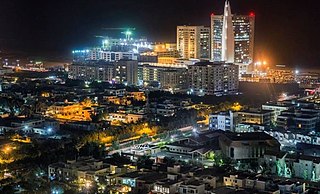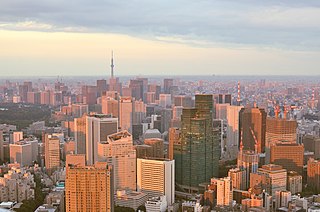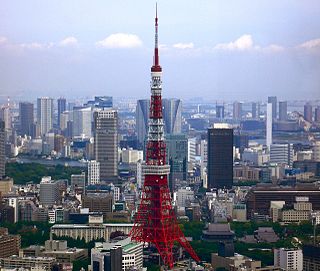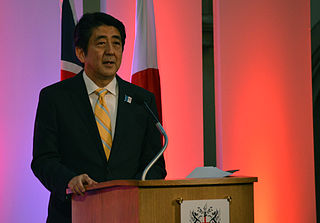
A keiretsu is a set of companies with interlocking business relationships and shareholdings. It is a type of informal business group. The keiretsu maintained dominance over the Japanese economy for the second half of the 20th century, and into a lesser extend, the early 21st century.

The economy of Malaysia is the 3rd largest in Southeast Asia, and is the 38th largest economy in the world. Malaysian labour productivity is significantly higher than neighbouring Thailand, Indonesia, Philippines or Vietnam due to a high density of knowledge-based industries and adoption of cutting edge technology for manufacturing and digital economy. According to the Global Competitiveness Report 2017, the Malaysian economy is the 23rd most competitive country in the world in the period of 2017–18.

The economy of Pakistan is the 23rd largest in the world in terms of purchasing power parity (PPP), and 38th largest in terms of nominal gross domestic product. Pakistan has a population of over 207 million, giving it a nominal GDP per capita of $1,641 in 2018, which ranks 147th in the world and giving it s PPP GDP per capita of 5,709 in 2018, which ranks 130th in the world for 2018. However, Pakistan's undocumented economy is estimated to be 36% of its overall economy, which is not taken into consideration when calculating per capita income. Pakistan is a developing country and is one of the Next Eleven countries identified by Jim O'Neill in a research paper as having a high potential of becoming, along with the BRICS countries, among the world's largest economies in the 21st century. The economy is semi-industrialized, with centres of growth along the Indus River. Primary export commodities include textiles, leather goods, sports goods, chemicals, carpets/rugs and medical instruments.

Fukuoka is the capital city of Fukuoka Prefecture, situated on the northern shore of Japanese island Kyushu. It is the most populous city on the island, followed by Kitakyushu. It is the largest city and metropolitan area west of Keihanshin. The city was designated on April 1, 1972, by government ordinance. Greater Fukuoka, with a population of 2.5 million people, is part of the heavily industrialized Fukuoka–Kitakyushu zone.
The business cycle, also known as the economic cycle or trade cycle, is the downward and upward movement of gross domestic product (GDP) around its long-term growth trend. The length of a business cycle is the period of time containing a single boom and contraction in sequence. These fluctuations typically involve shifts over time between periods of relatively rapid economic growth, and periods of relative stagnation or decline.

The economic history of Japan is most studied for the spectacular social and economic growth in the 1800s after the Meiji Restoration, when it became the first non-Western great power, and for its expansion after the Second World War, when Japan recovered from devastation to become the world's second largest economy behind the United States, and from 2013 behind China as well. Scholars have evaluated the nation's unique economic position during the Cold War, with exports going to both U.S.- and Soviet-aligned powers, and have taken keen interest in the situation of the post-Cold War period of the Japanese "lost decades".

The economy of Asia comprises more than 4.5 billion people living in 49 different nation states. Six further states lie partly in Asia, but are considered to belong to another region economically and politically. Asia is the fastest growing economic region, as well as the largest continental economy by both GDP Nominal and PPP in the world. China, Japan, India, South Korea and Indonesia are currently the top five economies in Asia. Moreover, Asia is the site of some of the world's longest modern economic booms, starting from the Japanese economic miracle (1950–1990), Miracle on the Han River (1961–1996) in South Korea, economic boom (1978–2013) in China and economic boom in India (1991–present).

The economy of India is a developing mixed economy. It is the world's seventh-largest economy by nominal GDP and the third-largest by purchasing power parity (PPP). The country ranks 139th in per capita GDP (nominal) with $2,134 and 122nd in per capita GDP (PPP) with $7,783 as of 2018. After the 1991 economic liberalisation, India achieved 6-7% average GDP growth annually. Since 2014 with the exception of 2017, India's economy has been the world's fastest growing major economy, surpassing China.
The early 2000s recession was a decline in economic activity which mainly occurred in developed countries. The recession affected the European Union during 2000 and 2001 and the United States in 2002 and 2003. The UK, Canada and Australia avoided the recession, while Russia, a nation that did not experience prosperity during the 1990s, in fact began to recover from said situation. Japan's 1990s recession continued. This recession was predicted by economists, because the boom of the 1990s slowed in some parts of East Asia during the 1997 Asian financial crisis. The recession in industrialized countries wasn't as significant as either of the two previous worldwide recessions. Some economists in the United States object to characterizing it as a recession since there were no two consecutive quarters of negative growth.

The Shōwa Financial Crisis was a financial panic in 1927, during the first year of the reign of Emperor Hirohito of Japan, and was a foretaste of the Great Depression. It brought down the government of Prime Minister Wakatsuki Reijirō and led to the domination of the zaibatsu over the Japanese banking industry.

Quantitative easing (QE), also known as large-scale asset purchases, is an expansionary monetary policy whereby a central bank buys predetermined amounts of government bonds or other financial assets in order to stimulate the economy and increase liquidity. An unconventional form of monetary policy, it is usually used when inflation is very low or negative, and standard expansionary monetary policy has become ineffective. A central bank implements quantitative easing by buying specified amounts of financial assets from commercial banks and other financial institutions, thus raising the prices of those financial assets and lowering their yield, while simultaneously lowering short term interest rates which increases the money supply. This differs from the more usual policy of buying or selling short-term government bonds to keep interbank interest rates at a specified target value.

Kiso Observatory is an astronomical observatory located at Mt. Ontake in Japan. The observatory was founded in 1974, originally as a branch observatory of the Tokyo Astronomical Observatory, with the express objective of studying extra-galactic astronomical objects. Since 1988, it has been maintained by the Institute of Astronomy, Faculty of Science, University of Tokyo. It is home to the 105 cm Schmidt Telescope. It is currently open for use by astronomers from all over the world.

The Economy of East Asia comprises more than 1.6 billion people living in 6 different countries. East Asia is home to one of the most economically dynamic places in the world. The region is the site to some of the world's longest modern economic booms, starting from the Japanese economic miracle (1950–1990), Miracle on the Han River (1961–1996) in South Korea, the Taiwan miracle in Taiwan (1960–1996) and the economic boom (1978–2015) in Mainland China. The region is home of some of the world's largest and most prosperous economies: Mainland China, Hong Kong, Macau, Japan, South Korea, and Taiwan. As East Asia's economic prominence has grown, so has its importance and influence in the world economy. It has emerged as an increasingly prominent region in the Asian continent and in the global economy and international politics as a whole. East Asia now boasts an expanding cosmopolitan middle class, where its members are linked to the global communications grid that are identifying with its Western counterparts across the world making it a significant force to be reckoned with in the global economy. The region's economic success has led to it being dubbed "An East Asian renaissance" by the World Bank in 2007.

The economy of Ireland is a knowledge economy, focused on services into high-tech, life sciences and financial services industries. Ireland is an open economy, and ranks first for high-value foreign direct investment (FDI) flows. In the global GDP per capita tables, Ireland ranks 5th of 187 in the IMF table and 6th of 175 in the World Bank ranking.

The Lost Decade or the Lost 10 Years is a period of economic stagnation in Japan following the Japanese asset price bubble's collapse in late 1991 and early 1992. The term originally referred to the years from 1991 to 2000, but recently the decade from 2001 to 2010 is often included so that the whole period is referred to as the Lost Score or the Lost 20 Years. Broadly impacting the entire Japanese economy, over the period of 1995 to 2007, GDP fell from $5.33 trillion to $4.36 trillion in nominal terms, real wages fell around 5%, while the country experienced a stagnant price level. While there is some debate on the extent and measurement of Japan's setbacks, the economic effect of the Lost Decade is well established and Japanese policymakers continue to grapple with its consequences.

Abenomics refers to the economic policies advocated by Shinzō Abe since the December 2012 general election, which elected Abe to his second term as Prime Minister of Japan. Abenomics is based upon "three arrows" of monetary easing, fiscal stimulus and structural reforms. The Economist characterized the program as a "mix of reflation, government spending and a growth strategy designed to jolt the economy out of suspended animation that has gripped it for more than two decades".
The Asian Infrastructure Investment Bank (AIIB) is a multilateral development bank that aims to support the building of infrastructure in the Asia-Pacific region. The bank currently has 69 members as well as 24 prospective members from around the world. The bank started operation after the agreement entered into force on 25 December 2015, after ratifications were received from 10 member states holding a total number of 50% of the initial subscriptions of the Authorized Capital Stock.















